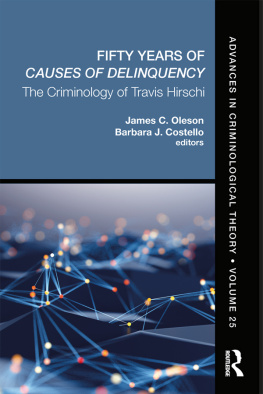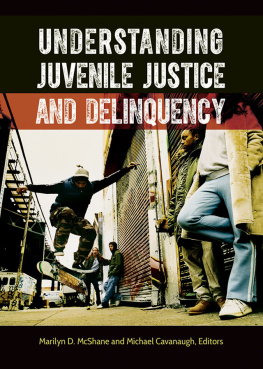Originally published in 1967 by The Free Press. The 1973 Preface was originally published by The Free Press.
Published 1996 by Transaction Publishers
Published 2017 by Routledge
2 Park Square, Milton Park, Abingdon, Oxon OX14 4RN
711 Third Avenue, New York, NY 10017, USA
Routledge is an imprint of the Taylor & Francis Group, an informa business
New material this edition copyright 1996 by Taylor & Francis
All rights reserved. No part of this book may be reprinted or reproduced or utilised in any form or by any electronic, mechanical, or other means, now known or hereafter invented, including photocopying and recording, or in any information storage or retrieval system, without permission in writing from the publishers.
Notice:
Product or corporate names may be trademarks or registered trademarks, and are used only for identification and explanation without intent to infringe.
Library of Congress Catalog Number: 95-9211
Library of Congress Cataloging-in-Publication Data
Hirschi, Travis.
Delinquency research : an appraisal of analytic methods / Travis Hirschi and Hanan C. Selvin ; with a new introduction by Travis Hirschi.[New ed.]
p. cm.
Includes index.
ISBN 1-56000-843-1 (paper : alk. paper)
1. Juvenile delinquencyResearch. 2. Juvenile delinquencyStudy and teaching. I. Selvin, Hanan C. (Hanan Charles) II. Title. HV9068.H5 1995
364.36'2'0723dc20 95-9211
CIP
ISBN 13: 978-1-56000-843-9 (pbk)
Introduction to the Transaction Edition
The summer following my first year of graduate school at Berkeley (1960-61), I worked as a research assistant to Hanan Selvin on a project designed to catalog the statistical techniques employed in delinquency research. Scheduled to last a few months, this project ended up consuming much of my spare time for the next five years, and the final product bore little resemblance to the original plan. In the end, Delinquency Research: An Appraisal of Analytic Methods (Free Press, 1967) examined with a critical eye analyses of quantitative data on delinquency published prior to 1960.
The book was conceived and largely written during a moment of optimism in sociology. This optimism was based on clear and impressive advances on three fronts: The computer was already capable of processing in minutes data sets previously beyond the realistic reach of even the most dedicated researcher. Survey research had been shown to be reliable in a variety of areas, and large improvements in its understanding and technology were everywhere in evidence. Not least, a generation sufficiently knowledgeable in statistics and data analysis to take advantage of these improvements was on the scene. Taken together, these circumstances could be expected quickly and dramatically to revolutionize thinking in all substantive areas of social science.
Delinquency, a subfield of sociology, was especially likely to benefit from this state of affairs. For various reasons, it had not been especially attractive to the best minds in the field and would thus be easy pickings for anyone inclined to take advantage of an opportunity.
Or, at least, this is how I remember the situation at the time. And no wonder: Hanan Selvin was an enthusiastic student of mathematical statistics; the computer and its products were the first item of business at his research-project meetings; he shared the confidence of Paul Lazarsfelds students in the ability of analysis to overcome all obstacles; and he did not think much of criminology (in the end allowing or requiring me to assume responsibility for all selections from the literature of delinquency [p. xxx]).
Reading the book today reinforces my memories of the setting in which it was written. It generally exudes a confident optimism that well-conducted research and analysis will quickly lead to important advances in the field. Thirty-three years after the project was conceived, and twenty-seven years after the book was published, the validity of its optimistic view seems to me to have been confirmed by events. We know much about crime and delinquency, and we know better how to study them. In fact, as a field, criminology may now be said to be among the leading producers of high-quality research in the social sciences. (Richard Herrnstein, a psychologist, refers to the enormous empirical literature on the characteristics of offenders [1995: 49].)
Ironically, the external arguments for optimism proved untrustworthy. The computer may have encouraged collection of massive and potentially highly useful sets of data, but its lightning speed is of limited value in the absence of clearly articulated or meaningful questions. Survey research, too, for all its strengths, eventually fell victim to its unique and almost uncanny ability to document its own weaknesses, especially in the area of crime and delinquency. By the same token, experience soon revealed that knowledge of statistics and multivariate analysis, however sophisticated, was insufficient to guarantee theoretical or substantive contribution.
What, then, is the basis of the books predictive success? What were the authentic sources of its optimism? In my judgment, the book correctly anticipated the future of delinquency research because it started with and stood by the premise that substantive knowledge is the purpose of research and the ultimate concern of methodology. Only rarely does it treat its own intellectual problems as superior to those facing researchers interested in delinquency. Put another way, the stance of the book is not fully captured by the riddle on page 8:
A methodological riddle: When it comes to reading the report of an empirical study, what is the difference between a layman, a researcher, and a methodologist? Answer: The layman reads the text and skips the tables; the researcher reads the tables and skips the text; and the methodologist does not care very much about either the tables or the text, as long as they agree with each other.
This riddle neglects a set of very important persons: students of the phenomenon in question, scholars genuinely interested in explaining or understanding delinquency. They cannot afford to skip the tables or the text, and they must care very much about the agreement between them.
In fact, the point of view of students of delinquency is fully represented in Delinquency Research. Most of its methodological discussions are tied directly to identifiable substantive issues in the field. Except on rare occasions, they are not about corn or pigs, hospital patients, or hypothetical variables. They can thus be judged on substantive as well as methodological grounds.
This feature of the book was not produced by clever planning, but by our definition of our task. We did not set out to bring methodological principles to delinquency research so much as to derive principles of methodology from the real problems encountered by researchers in the field. Questions of pain and effort (efficiency) aside, our strategy was largely inductive. This strategy limited the books market as a text (making it difficult to produce a table of contents in advance) but had the advantage that it tended to lead to actual rather than to potential research issues, and thus tended to produce concrete solutions to real problems rather than vague warnings about hypothetical dangers.







